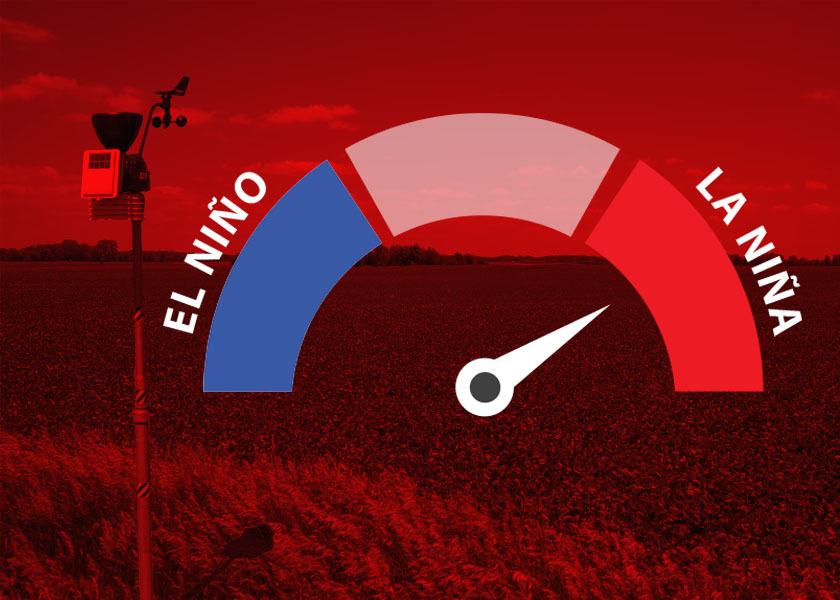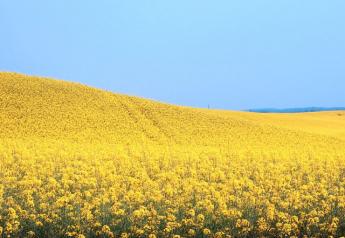Third Year of La Niña on the Horizon as Drought Continues in the Plains

Drought on the mind again this summer? Many ag experts say it should be now, and next year.
The latest drought monitor released on Thursday showed improvements in key drought areas, such as Texas and western-central Kansas. But the improvements were only a “small dent in the larger drought picture,” according to John Homenuk of empireweather.com.
“The medium-term forecast for the next 30 days or so doesn’t look all that great,” he says. “It looks a lot drier and a lot warmer.”
La Niña vs El Niño
Drier and warmer climates are consistent with the La Niña weather pattern we’re currently in, according to Columbia University’s IRI Forecast Group.
Eric Snodgrass, principal atmospheric scientist at Nutrien Ag Solutions, says La Niña is dreaded term in the ag industry as it’s a semi-unpredictable weather pattern that robs jet stream movement over the Midwest, resulting in too much or too little rain.
That dread doesn’t seem to be slowing in 2022, as IRI reported in May that the current La Niña could exhibit a stronger influence in summer 2022 weather outlooks due to the pattern’s persistent track record this spring.
“In broad terms, this reduces summer extreme heat risk across the West and increases the risk of drought development/expansion and summer heat in the Central U.S.,” IRI wrote.
The forecast group says the pattern raises the odds that any developing hurricane in the Atlantic will yield stronger inland storms.
Back-to-Back-to-Back
La Nina is Spanish for “little girl,” but its forecasted impacts look far from little.
According to Dennis Todey, USDA Midwest Climate Hub director, we’re in the midst of a back-to-back La Niña weather pattern, with the potential to enter into a third year of this extreme pattern that often brings drought and lesser-than crop yields.
“We’ve had two of these back-to-back starting in the fall of 2020 and into present day,” he says. “We thought it would maybe weaken, and it did weaken a little bit this spring, but it has strengthened, and the forecasts indicate it’s more likely than not that it continues into a third year.”
Two consecutive years of La Niña are not uncommon, according to Todey, but three years is nearly unheard of. Since 1950, he says there have been only two other documented instances of three years of La Nina.
What to Watch
As we approach the possibility of a third season of La Niña, Todey says to keep an eye on July and August outlooks.
“El Ninos tend to yield better growing seasons—they may not be great growing seasons, but they tend not to be bad,” he says. “Increased risk of hotter and drier conditions over the Corn Belt during La Nina summers in that July to August timeframe can still hurt corn more.”
To gauge the likelihood of La Nina impacts in that reproductive season, we can look at National Weather Service’s (NWS) mean sea surface temperature data from 2020 and 2021—the past two years of La Niña.
NWS classifies La Niña’s as weak to strong when sea surface temperatures strike -0.5˚C to -1.5˚C or less. Their data shows July 2020 and 2021 season’s temperatures were in the -0.4˚C range, which is considered normal, or what some call “La Nada.”
August 2020 and 2021 seasons, however, transition to -0.6˚C and -0.5˚C range, pushing the pattern into the new, cold La Niña loop.
With such a small window of variation in “La Nada” to La Niña temperature ranges over the years, we can turn to forecasts and continue to hope for the best.
Snodgrass says to keep in mind weather predictions between 14- and 45-days are considered “no man’s land,” but do have a track-record of better performance in the three- to nine-month range.
“What’s interesting is we actually have better predictions in that long-term range because we’re looking month-by-month at the chances of being above or below average, with respect to some variable precipitation or temperature,” Snodgrass says.
More on weather:
The U.S. Just Broke a 27-Week Drought Streak, But Forecasts Don't Look Promising







